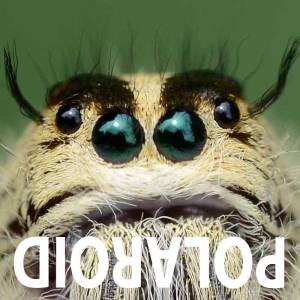Incy Mincy
Continuing on from the last two days, this little critter appeared right in front of me, begging to be blipped. I did have a series of blips of my house visitors planned for the future, but roaches, dragonflies and spindly spiders were not on the guest list. Once again, my planned blip gets pushed aside, as I have to go with the flow of this mini series that has imposed itself upon me.
Often when I am walking about my house, I feel a strand of web get caught on my face and just wipe it away without a second thought. Up until this morning, I have never seen the arachnid that was putting out that errant strand. It?s body looked no more than a couple of millimeters in length, with 15mm long legs, but looking at the blip, the legs may have been a lot longer than my estimation. With my poor eye sight, it looked harmless enough, but as you all know, judging by some of the very fine macro blips on display, you don?t really ?see? an insect until you have photographed it.
If you can stand to look at the arachnid zoomed in, you will see that it has significant chelicerae, the jointed weapons culminating with the hypodermic needles used to inject their prey with flesh dissolving poison and scoop the food into its mouth on its underside. These are visible as the two bumps at the top end of the body in the blip. If you look closely, you can just see the needles too. The body and legs are also covered in very fine hairs. These features are hardly visible with the naked eye, mainly because you are not looking for them. You can also see the ball of web strands that it collects as it raises and lowers itself.
Spiders generally are broken down into two types, ancient and modern, referring to its evolutionary background. Modern spiders, the chelicerae attack more from the side, they are traditional web builders and generally have good eye sight. Looking at the needles of this critter, tucked under its body, combined with the single strand web and the fact that it did not see me at all, even when I put my finger within millimeters of it, I would deduct that this was of the ancient type of spider, but there are contradictions to this assumption.
All spiders make webs, but the ancient spider mainly used the web for protecting the egg sac. It also left an irregular and crude mat of web on the ground, to sense unwelcome visitors and dinner. They are generally ground dwellers and hunt by ambush. There are always exceptions to these general rules and I suspect this particular spider is one of them, as it lays a single long strand of web, presumable to snag an unsuspecting flying insect (or me) and I think it is responsible for the wispy tangle of web found around the ceiling edges, just out of reach of my broom. Spiders evolved from ancient to modern, many species will be found between the two types. I could be very wrong in my deductions and will happily accept correction from any arachnidists out there.
I could write many pages on spiders, but I will stop here, as I know it gets tedious to be faced with too much text.
Dave
- 1
- 0
- Olympus E-10
- 1/100
- f/2.4
- 36mm
- 80

Comments
Sign in or get an account to comment.


